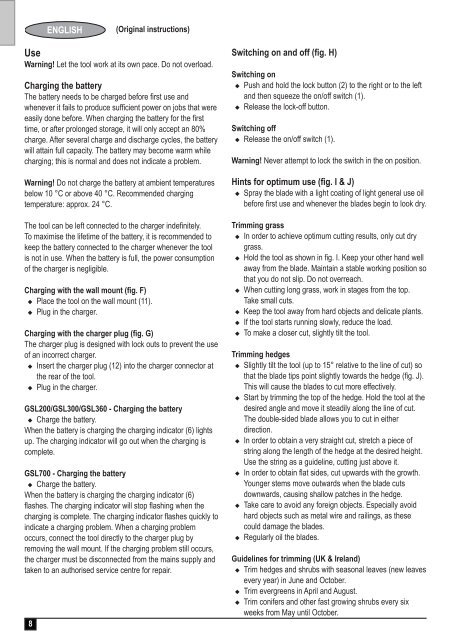BlackandDecker Debroussaileuse- Gsl700 - Type H1 - Instruction Manual (Européen)
BlackandDecker Debroussaileuse- Gsl700 - Type H1 - Instruction Manual (Européen)
BlackandDecker Debroussaileuse- Gsl700 - Type H1 - Instruction Manual (Européen)
Create successful ePaper yourself
Turn your PDF publications into a flip-book with our unique Google optimized e-Paper software.
ENGLISH<br />
(Original instructions)<br />
Use<br />
Warning! Let the tool work at its own pace. Do not overload.<br />
Charging the battery<br />
The battery needs to be charged before first use and<br />
wh<strong>en</strong>ever it fails to produce suffici<strong>en</strong>t power on jobs that were<br />
easily done before. Wh<strong>en</strong> charging the battery for the first<br />
time, or after prolonged storage, it will only accept an 80%<br />
charge. After several charge and discharge cycles, the battery<br />
will attain full capacity. The battery may become warm while<br />
charging; this is normal and does not indicate a problem.<br />
Warning! Do not charge the battery at ambi<strong>en</strong>t temperatures<br />
below 10 °C or above 40 °C. Recomm<strong>en</strong>ded charging<br />
temperature: approx. 24 °C.<br />
The tool can be left connected to the charger indefinitely.<br />
To maximise the lifetime of the battery, it is recomm<strong>en</strong>ded to<br />
keep the battery connected to the charger wh<strong>en</strong>ever the tool<br />
is not in use. Wh<strong>en</strong> the battery is full, the power consumption<br />
of the charger is negligible.<br />
Charging with the wall mount (fig. F)<br />
u Place the tool on the wall mount (11).<br />
u Plug in the charger.<br />
Charging with the charger plug (fig. G)<br />
The charger plug is designed with lock outs to prev<strong>en</strong>t the use<br />
of an incorrect charger.<br />
u Insert the charger plug (12) into the charger connector at<br />
the rear of the tool.<br />
u Plug in the charger.<br />
GSL200/GSL300/GSL360 - Charging the battery<br />
u Charge the battery.<br />
Wh<strong>en</strong> the battery is charging the charging indicator (6) lights<br />
up. The charging indicator will go out wh<strong>en</strong> the charging is<br />
complete.<br />
GSL700 - Charging the battery<br />
u Charge the battery.<br />
Wh<strong>en</strong> the battery is charging the charging indicator (6)<br />
flashes. The charging indicator will stop flashing wh<strong>en</strong> the<br />
charging is complete. The charging indicator flashes quickly to<br />
indicate a charging problem. Wh<strong>en</strong> a charging problem<br />
occurs, connect the tool directly to the charger plug by<br />
removing the wall mount. If the charging problem still occurs,<br />
the charger must be disconnected from the mains supply and<br />
tak<strong>en</strong> to an authorised service c<strong>en</strong>tre for repair.<br />
8<br />
Switching on and off (fig. H)<br />
Switching on<br />
u Push and hold the lock button (2) to the right or to the left<br />
and th<strong>en</strong> squeeze the on/off switch (1).<br />
u Release the lock-off button.<br />
Switching off<br />
u Release the on/off switch (1).<br />
Warning! Never attempt to lock the switch in the on position.<br />
Hints for optimum use (fig. I & J)<br />
u Spray the blade with a light coating of light g<strong>en</strong>eral use oil<br />
before first use and wh<strong>en</strong>ever the blades begin to look dry.<br />
Trimming grass<br />
u In order to achieve optimum cutting results, only cut dry<br />
grass.<br />
u Hold the tool as shown in fig. I. Keep your other hand well<br />
away from the blade. Maintain a stable working position so<br />
that you do not slip. Do not overreach.<br />
u Wh<strong>en</strong> cutting long grass, work in stages from the top.<br />
Take small cuts.<br />
u Keep the tool away from hard objects and delicate plants.<br />
u If the tool starts running slowly, reduce the load.<br />
u To make a closer cut, slightly tilt the tool.<br />
Trimming hedges<br />
u Slightly tilt the tool (up to 15° relative to the line of cut) so<br />
that the blade tips point slightly towards the hedge (fig. J).<br />
This will cause the blades to cut more effectively.<br />
u Start by trimming the top of the hedge. Hold the tool at the<br />
desired angle and move it steadily along the line of cut.<br />
The double-sided blade allows you to cut in either<br />
direction.<br />
u In order to obtain a very straight cut, stretch a piece of<br />
string along the l<strong>en</strong>gth of the hedge at the desired height.<br />
Use the string as a guideline, cutting just above it.<br />
u In order to obtain flat sides, cut upwards with the growth.<br />
Younger stems move outwards wh<strong>en</strong> the blade cuts<br />
downwards, causing shallow patches in the hedge.<br />
u Take care to avoid any foreign objects. Especially avoid<br />
hard objects such as metal wire and railings, as these<br />
could damage the blades.<br />
u Regularly oil the blades.<br />
Guidelines for trimming (UK & Ireland)<br />
u Trim hedges and shrubs with seasonal leaves (new leaves<br />
every year) in June and October.<br />
u Trim evergre<strong>en</strong>s in April and August.<br />
u Trim conifers and other fast growing shrubs every six<br />
weeks from May until October.
















